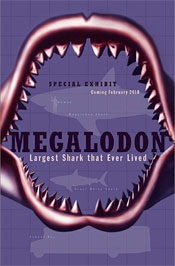February 13–May 9, 2010
At 60 feet long, Carcharodon megalodon was the largest shark that ever lived and a dominant marine predator. Sharks are at risk today, with recent population declines attributed to humans. While the Megalodon vanished 2 million years ago, its fascinating story inspires lessons for contemporary science and shark conservation.
This unique exhibit showcases both fossil and modern shark specimens, as well as full-scale models from several collections. Visitors enter a full-sized sculpture of Megalodon through massive jaws and discover this shark’s history and the world it inhabited, including its physiology, diet, lifespan, relatives, neighbors, evolution and extinction.
The exhibit also provides details on how to improve the health of our oceans and survival of threatened species. Recent worldwide declines are attributed to commercial and sport overfishing. Scientists estimate that humans kill 100 million sharks, skates and rays each year, and the life history of most shark species makes it difficult for populations to rebound.
For those wondering why sharks should be saved, the exhibit asks visitors to consider the marine food-web domino effect caused by overfishing. Another section describes how this animal continues to fascinate many, elevating the Megalodon to near cult status. From biker jackets to postage stamps, the exhibition explains the many ways that the Megalodon remains a part of human culture through art, literature, music and film.
Megalodon was produced by the Florida Museum of Natural History with support from the National Science Foundation.


